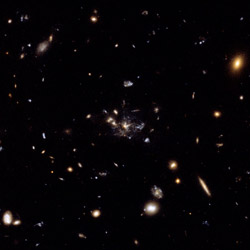Flies in a spider’s web: Galaxy caught in the making

This image is a composite of many separate exposures made by the ACS instrument on the Hubble Space Telescope using several different filters. It shows the Spiderweb Galaxy sitting at the centre of an emergent galaxy cluster, surrounded by hundreds of other galaxies from the cluster. The image provides a dramatic glimpse of a large massive galaxy under assembly as smaller galaxies merge. This has commonly been thought to be the way galaxies grew in the young Universe, but now the Hubble observations of the radio galaxy MRC 1138-262, nicknamed the “Spiderweb Galaxy”, have shown dozens of star-forming satellite galaxies in the actual process of merging.
Analogously, the NASA/ESA Hubble Space Telescope has found a large galaxy 10.6 billion light-years away from Earth (at a redshift of 2.2) that is stuffing itself with smaller galaxies caught like flies in a web of gravity. The galaxy is so far away that astronomers are seeing it as it looked in the early formative years of the Universe, only 2 billion years after the Big Bang.
The Hubble image shows the Spiderweb Galaxy sitting at the centre of an emergent galaxy cluster, surrounded by hundreds of other galaxies from the cluster.
Team leader George Miley from Leiden Observatory in the Netherlands explains: “The new Hubble image is the best demonstration so far that large massive galaxies are built up by merging smaller ones.” The image reaches much deeper than previous ones and shows the merging process in unprecedented detail. Galaxies can be seen as they are sucked into the Spiderweb at speeds of several hundred kilometres per second, from distances of more than a hundred thousand light-years around it.
Radio telescopes have shown that jets of fast particles are being spewed out from the centre of the Spiderweb Galaxy with enormous energies. These jets are believed to be produced by a massive black hole buried deep in the nucleus of the system. The infalling galaxy “flies” are a source of food for this black hole “spider”, allowing it to continue disgorging the jets.
The new Hubble image provides a unique real-world example for testing theoretical models of massive galaxy formation. The complexity and clumpiness of the Spiderweb agrees qualitatively with the predictions of such models, but a surprising feature of the Spiderweb Galaxy is the presence of several faint small linear galaxies within the merging structure.
The Spiderweb Galaxy is located in the southern constellation of Hydra (the water snake) and is one of the most massive galaxies known.
This result was published 10th October 2006 in Astrophysical Journal Letters.
Media Contact
More Information:
http://www.spacetelescope.org/news/html/heic0614.htmlAll latest news from the category: Physics and Astronomy
This area deals with the fundamental laws and building blocks of nature and how they interact, the properties and the behavior of matter, and research into space and time and their structures.
innovations-report provides in-depth reports and articles on subjects such as astrophysics, laser technologies, nuclear, quantum, particle and solid-state physics, nanotechnologies, planetary research and findings (Mars, Venus) and developments related to the Hubble Telescope.
Newest articles

Superradiant atoms could push the boundaries of how precisely time can be measured
Superradiant atoms can help us measure time more precisely than ever. In a new study, researchers from the University of Copenhagen present a new method for measuring the time interval,…

Ion thermoelectric conversion devices for near room temperature
The electrode sheet of the thermoelectric device consists of ionic hydrogel, which is sandwiched between the electrodes to form, and the Prussian blue on the electrode undergoes a redox reaction…

Zap Energy achieves 37-million-degree temperatures in a compact device
New publication reports record electron temperatures for a small-scale, sheared-flow-stabilized Z-pinch fusion device. In the nine decades since humans first produced fusion reactions, only a few fusion technologies have demonstrated…





















